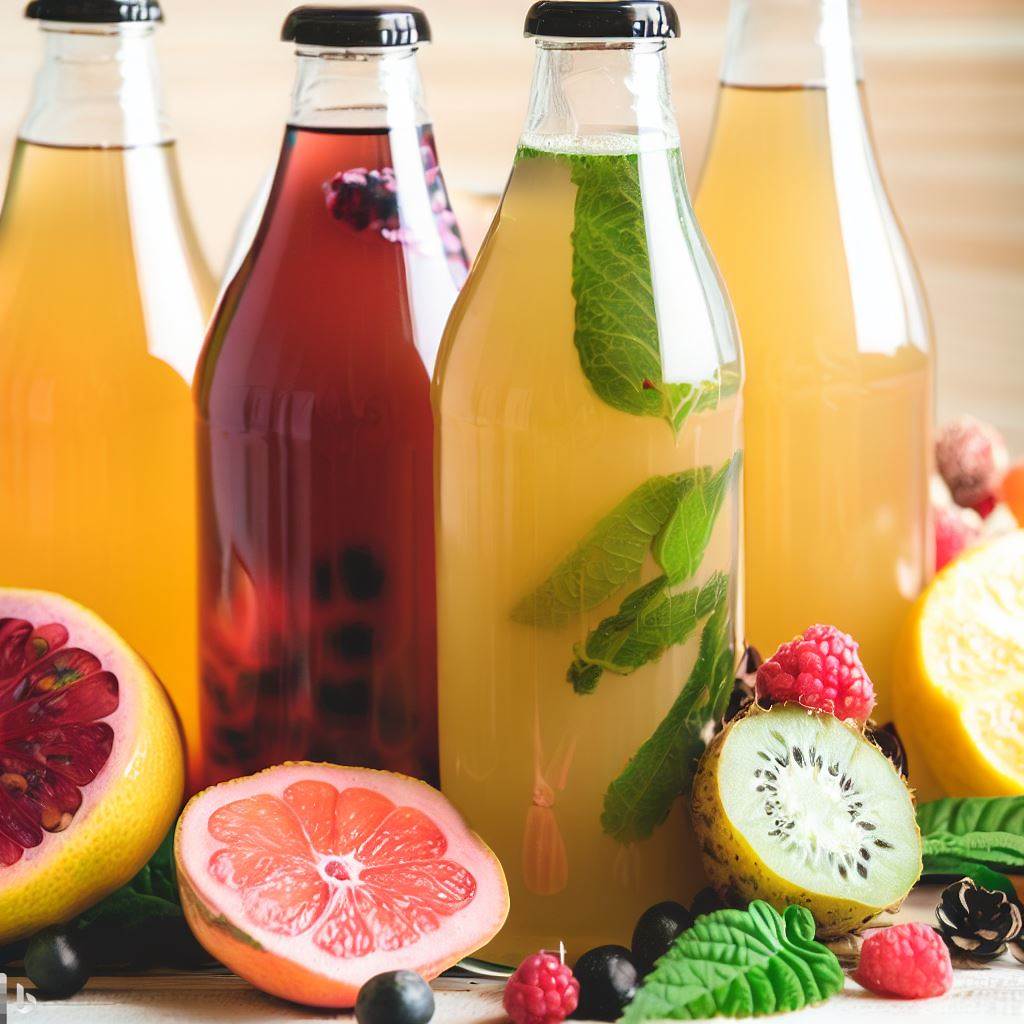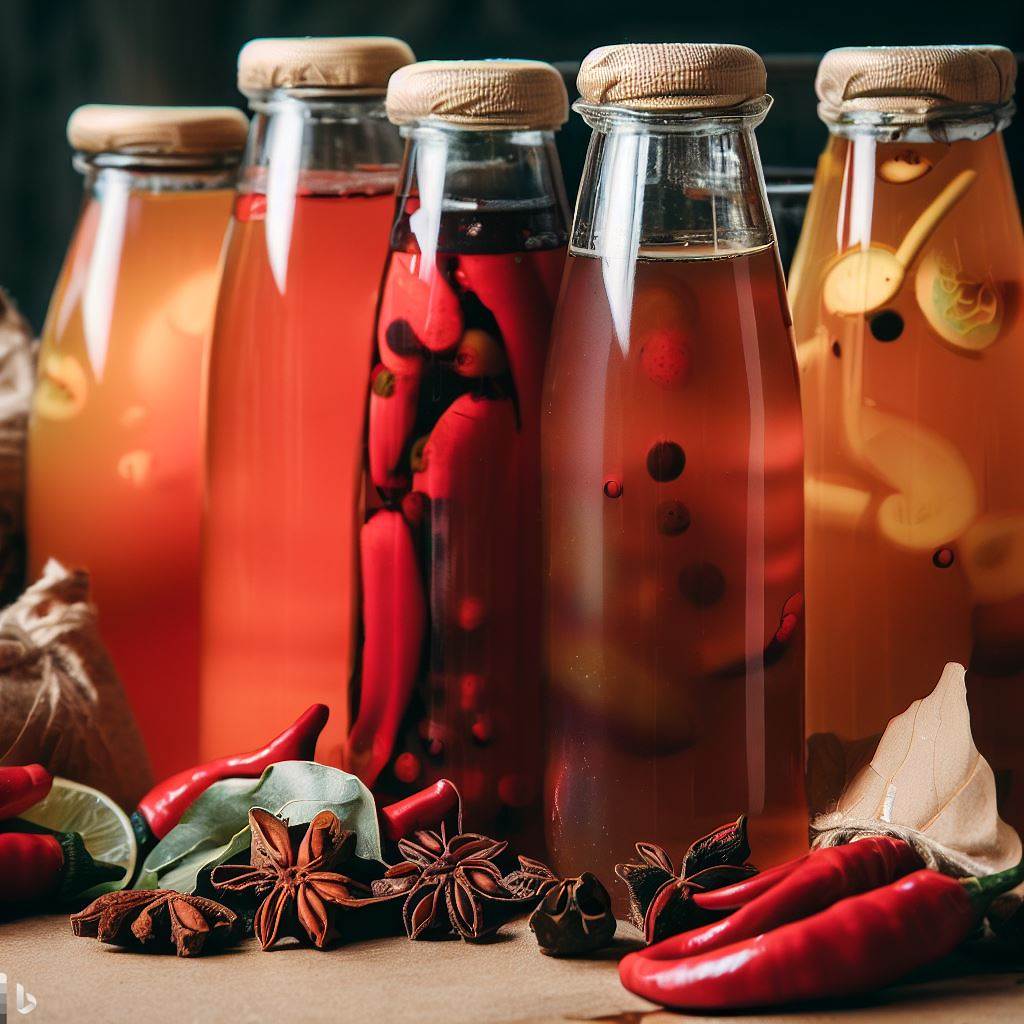Kombucha is a tangy tea beverage that has gained popularity for its unique flavor profile and potential health benefits. It is made by combining sweetened tea with a SCOBY, which stands for Symbiotic Culture of Bacteria and Yeast. As the SCOBY consumes the sugar in the tea, it produces a range of organic acids, probiotics, and carbonation, resulting in a tangy and effervescent drink. But what about Kombucha Flavors? Lets dive into the details and 23 ideas on Kombucha Flavors for you!
Comprehensive Guide to Kombucha Flavors and 23 Flavor Ideas
Kombucha originated in China over 2,000 years ago and has since been enjoyed in various cultures worldwide. It is believed to have detoxifying properties and is often praised for its probiotic content, which can support gut health and digestion.

Brief History of Kombucha
Kombucha’s exact origins are unclear, but it is thought to have originated in Northeast China during the Qin Dynasty (221-206 BC). It then spread to Japan, Russia, and other parts of the world. In recent years, kombucha has experienced a resurgence in popularity, with many people brewing their own at home and experimenting with different flavors.
Health Benefits of Kombucha
Kombucha is often touted for its potential health benefits, although more scientific research is needed to fully understand its effects on the human body. Some of the claimed benefits include:
- Improved digestion and gut health due to its probiotic content.
- Detoxification properties attributed to the presence of antioxidants and organic acids.
- Potential immune system support from the vitamins and minerals present in kombucha.
- Increased energy and mental clarity, attributed to the small amount of caffeine and B-vitamins in the tea.
While kombucha can be a nutritious addition to a balanced diet, it’s important to note that individual experiences may vary, and it’s always best to consult with a healthcare professional for personalized advice or if you have any specific health concerns.
Getting Started with Flavoring Kombucha
Flavoring kombucha is a creative and exciting process that allows you to customize the taste of your brew. Before diving into the world of flavor combinations, it’s important to have a solid foundation in brewing the basic kombucha recipe.
Classic Kombucha Recipe

To make kombucha, you’ll need the following ingredients but checkout our Brewing Supplies page on how to get these important materials:
- 1 SCOBY (Symbiotic Culture of Bacteria and Yeast)
- 8 cups of water
- 4-6 tea bags or 2-3 tablespoons of loose tea
- 1 cup of granulated sugar
Here’s a step-by-step guide to brewing kombucha, but you may want to dive into GMK’s Comprehensive Guide to Brewing Kombucha:
- Boil the water and remove it from heat.
- Add the tea bags or loose tea to the hot water and steep for 5-7 minutes.
- Remove the tea bags or strain out the loose tea.
- Stir in the sugar until it dissolves completely.
- Allow the sweetened tea to cool to room temperature.
- Transfer the cooled tea to a clean brewing vessel.
- Gently place the SCOBY on top of the tea.
- Cover the vessel with a breathable cloth or coffee filter and secure it with a rubber band.
- Store the vessel in a warm and well-ventilated area, away from direct sunlight.
- Let the kombucha ferment for 7-14 days, depending on your taste preferences.
Importance of Fermentation Time
The fermentation time plays a crucial role in the flavor development of kombucha. The longer you ferment, the more tart and acidic the brew becomes. It’s essential to taste your kombucha regularly during the fermentation process to determine when it reaches your desired flavor profile. How many days do you ferment kombucha?
Essential Tools and Ingredients for Flavoring Kombucha
To start flavoring your kombucha, it’s important to have the right tools and ingredients on hand. Here are some essentials:
Brewing Vessel and Equipment
- Glass jars or fermentation vessels: These should be made of non-reactive material such as glass. Avoid using plastic containers, as they may harbor harmful chemicals or retain flavors.
- Brewing vessels with wide mouths: This makes it easier to add ingredients and retrieve the SCOBY.
- pH strips or a pH meter: These tools help monitor the acidity level of your kombucha during fermentation.
SCOBY (Symbiotic Culture of Bacteria and Yeast)
The SCOBY is the heart of the kombucha brewing process. It acts as the catalyst for fermentation, transforming the sweetened tea into tangy kombucha. You can obtain a SCOBY from a kombucha-brewing friend, purchase one online, or even grow your own from a bottle of raw, unflavored kombucha.
Tea and Sugar
Tea provides the essential nutrients and compounds for the SCOBY to thrive. Black tea is the most common choice due to its rich flavor and tannins. However, you can experiment with other teas like green tea or a combination of teas to create unique flavor profiles. It’s crucial to use regular tea (not herbal or flavored) to provide the necessary nutrients for the SCOBY.
Cane Sugar serves as the fuel for the fermentation process. The SCOBY consumes the sugar, producing the characteristic tanginess and carbonation of kombucha. Granulated white sugar is commonly used, but you can also use organic cane sugar or other types of sugar as long as they are fully dissolved.
Popular Flavoring Ideas for Kombucha
Flavoring kombucha allows you to unleash your creativity and experiment with various combinations. Here are some popular flavor ideas to inspire you:

Fruity Flavors
- Citrusy Combinations:
- Lemon and ginger: Add a zesty kick to your kombucha with the refreshing combination of lemon and ginger. It’s a perfect balance of tangy and spicy flavors.
- Orange and pineapple: Create a tropical twist by combining the citrusy flavors of orange with the sweetness of pineapple. It’s like a vacation in a bottle!
- Grapefruit and rosemary: The bright and slightly bitter notes of grapefruit pair wonderfully with the aromatic, herbal essence of rosemary.
- Berry Medleys:
- Raspberry and mint: The sweetness of raspberries pairs beautifully with the cooling freshness of mint. It’s a delightful burst of flavors.
- Blueberry and lavender: Experience the harmony of juicy blueberries and the floral, soothing aroma of lavender. It’s a match made in flavor heaven!
- Strawberry and basil: Combine the sweetness of strawberries with the herbaceous, slightly peppery taste of basil for a unique and refreshing blend.
- Tropical Blends:
- Mango and coconut: Transport yourself to a tropical paradise with the luscious combination of ripe mango and creamy coconut. It’s a taste of summer in every sip.
- Pineapple and jalapeno: Add a spicy twist to your kombucha with the combination of sweet pineapple and fiery jalapeno. It’s a flavor adventure for your taste buds.
- Kiwi and lime: Enjoy the tangy and tropical flavors of kiwi paired with the bright acidity of lime. It’s a vibrant and refreshing combination.
Herbal and Floral Flavors

- Minty Freshness:
- Peppermint and spearmint: Embrace the cooling and invigorating flavors of both peppermint and spearmint for a truly refreshing and uplifting kombucha.
- Peppermint and lavender: Combine the soothing qualities of lavender with the invigorating essence of peppermint for a calming and minty delight.
- Peppermint and chamomile: Experience the harmony of minty freshness and the gentle, floral notes of chamomile. It’s a soothing combination perfect for relaxation.
- Lavender Dreams:
- Lavender and lemon balm: Create a calming and aromatic blend by pairing lavender with lemon balm. It’s a dreamy and fragrant combination that promotes relaxation.
- Lavender and vanilla: Indulge in the sweet and floral flavors of lavender combined with the warm and comforting essence of vanilla. It’s like a cozy hug in a bottle.
- Lavender and rose: Immerse yourself in the elegance and romance of lavender and rose. It’s a floral infusion that adds a touch of sophistication to your kombucha.
- Chamomile Delight:
- Chamomile and honey: Combine the delicate flavors of chamomile with the natural sweetness of honey for a gentle and soothing kombucha. It’s a cup of serenity in every sip.
- Chamomile and peach: Enjoy the mellow and floral taste of chamomile infused with the juicy and fragrant essence of peach. It’s a harmonious blend of flavors.
Spicy and Savory Flavors

- Ginger Zing:
- Ginger and lemon: Experience the invigorating combination of spicy ginger and tangy lemon. It’s a fiery and citrusy kick that awakens your senses.
- Ginger and turmeric: Add a hint of earthiness and warmth to your kombucha by combining ginger with the vibrant yellow spice of turmeric.
- Cinnamon Warmth:
- Cinnamon and apple: Embrace the cozy flavors of cinnamon and apple for a comforting and nostalgic kombucha. It’s like sipping on a delicious apple pie.
- Cinnamon and pear: Combine the warm spiciness of cinnamon with the delicate sweetness of pear. It’s a delightful blend that captures the essence of autumn.
- Jalapeno Kick:
- Jalapeno and watermelon: Experience the unexpected pairing of spicy jalapeno with juicy watermelon. It’s a combination that balances heat and refreshing sweetness.
- Jalapeno and cucumber: Cool down the heat of jalapeno with the crisp and hydrating essence of cucumber. It’s a refreshing and invigorating flavor fusion.
Remember, these are just a few examples to spark your creativity. Feel free to mix and match different fruits, herbs, and spices to discover your own unique flavor combinations. Don’t be afraid to think outside the box and try something new.
Troubleshooting and Tips for Flavoring Kombucha
Flavoring kombucha can sometimes present challenges, but with a few tips and tricks, you’ll be able to overcome them and create delicious brews. Here are some troubleshooting tips and general advice to ensure successful flavoring:
- Preventing Contamination:
- Maintain cleanliness: Ensure that all equipment, utensils, and brewing vessels are thoroughly cleaned and sanitized to prevent any unwanted contamination.
- Practice good hygiene: Wash your hands thoroughly before handling the SCOBY or any flavoring ingredients.
- Store flavorings properly: If using fresh fruits or herbs, make sure they are properly washed and stored in clean containers before adding them to your kombucha.
- Adjusting Flavor Intensity:
- Taste regularly: Sample your kombucha during the secondary fermentation to assess the flavor intensity. If it’s not strong enough, you can extend the fermentation period or add more flavoring ingredients.
- Experiment with quantities: Start with small amounts of flavorings and gradually increase if desired. Remember, it’s easier to add more flavor than to tone it down if it becomes too overpowering.
- Managing Carbonation Levels:
- Burp the bottles: During the secondary fermentation, carbonation builds up. To avoid excessive pressure and potential bottle explosions, “burp” the bottles by carefully opening them to release some carbonation.
- Storage and Shelf Life:
- Refrigeration: Once your kombucha reaches the desired flavor and carbonation levels, transfer it to the refrigerator to slow down the fermentation process and preserve the flavors. This will also extend its shelf life.
- Properly seal bottles: Ensure that your bottles are tightly sealed to prevent carbonation from escaping and to maintain the fizziness of your flavored kombucha.
- Enjoy within a reasonable time: While kombucha can be stored for several weeks or even months, it’s best to consume it within a reasonable time frame to enjoy its optimal flavor and quality.
Wrapping Up
Finally, flavoring kombucha opens up a world of possibilities to enhance your brewing experience and create unique taste sensations. From fruity blends to herbal infusions and spicy combinations, there’s no limit to the flavors you can explore. Remember to have fun, experiment, and let your taste buds guide you.
As you embark on your flavoring journey, don’t forget the basics of kombucha brewing and the importance of maintaining cleanliness and monitoring fermentation time. With a little creativity and patience, you’ll be crafting delicious and refreshing kombucha flavors that will impress your friends and family.
So, go ahead and start experimenting with different combinations of fruits, herbs, and spices. Unleash your inner flavor artist and elevate your kombucha game to new heights. Cheers to a flavorful and enjoyable kombucha brewing experience! Happy Brewing y’all!
FAQ – Kombucha Flavors

- Can I use frozen fruits for flavoring kombucha?
- Absolutely! Frozen fruits can be a convenient option for flavoring kombucha. Just make sure to thaw them before adding them to your brew.
- How long should I let the kombucha ferment during the secondary fermentation?
- The duration of the secondary fermentation can vary depending on the desired level of carbonation and flavor intensity. Generally, it ranges from 2 to 7 days. Taste your kombucha regularly to find the perfect balance for your preference.
- Can I reuse the flavorings from one batch to another?
- While it is possible to reuse some flavorings, such as ginger or herbs, it’s important to ensure they are properly cleaned and sanitized before using them in a new batch. Some fruits, like berries or citrus slices, may not hold up well after fermentation and are best used fresh for each batch.
- What if my kombucha tastes too sour or vinegary after flavoring?
- If your kombucha tastes too sour or vinegary, it may have over-fermented. To balance the flavors, you can dilute it with a bit of fresh tea or fruit juice before consuming or use it as a starter liquid for your next batch to adjust the acidity.
- Can I carbonate my flavored kombucha in different containers besides bottles?
- While bottles are commonly used for secondary fermentation and carbonation, you can use other airtight containers like swing-top jars or even plastic bottles. Just ensure they can withstand the pressure build-up and hold the carbonation effectively.
Thanks for reading up at Greek Mountain Kombucha on Kombucha Flavors and Ideas. Read on!







